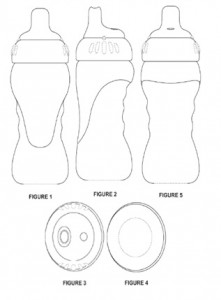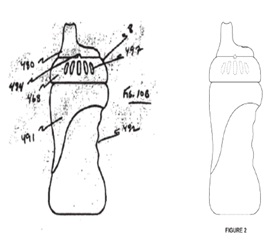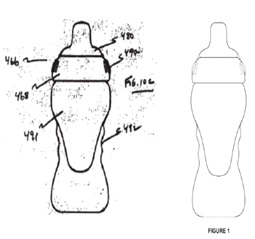Is the APJs’ Decision to Institute Design Patent IPR also their Final Decision?
| April 30, 2013
The APJs’ decision last week to institute inter partes review in Munchkin, Inc. et al. v. Luv’n Care, Ltd., IPR2013-00072 (involving Patent D617,465 for a baby’s drinking cup) has drawn a good deal of attention as the first IPR of a design patent, and rightfully so. If earlier experience with reexamination of design patents is any clue, inter partes review is likely to become a highly effective weapon for accused infringers to pursue validity challenges. Whereas original prosecution of design patents often resembles a registration system, reexamination of such patents is sometimes more like a killing field – the “kill rate” of design patents in both ex parte and inter partes reexamination being quite high.
Review of the text of the Munchkin decision itself, however, reveals what might be an even harsher outcome: that, at least in the case, the APJ’s decision to institute inter partes review is actually their final decision, holding the ‘465 patent invalid.
Luv’n Care’s patent claims a baby’s drinking cup having the following design:
Munchkin’s principal grounds for asserting that the ‘465 patent is invalid were that it is anticipated by either the Hakim ‘604 patent or the Hakim ‘225 patent. A threshold question was whether these two documents are, in fact, prior art. The APJs found that they are, holding that the ‘465 patent application is not entitled to benefit of the filing date of its parent application and that the two Hakim patents qualify as intervening prior art references under 35 U.S.C. § 102(b).
Figure 12a shows a top view of a spout, collar, and vessel although the vessel is barely visible. Figure 12a does not show the same design as that of the ’465 Patent, as best viewed in Figure 3 supra. For example, the ’106 Application, which shows a racetrack-shaped spout tip, does not disclose the claimed oval-shaped spout tip of the ’465 Patent. Also, the ’106 Application, which shows slits in the openings of the spout tip and vent, does not disclose the broader design of the ’465 Patent, which lacks any such slits.
For at least these reasons, possession of the claimed design of the ’465 Patent is not shown as of the filing date of the ’106 Application.
(Emphasis added).
Applying the “ordinary observer” standard from the CAFC’s decision in Egyptian Goddess, the APJs verbally described the salient features of the design shown in the ‘465 patent drawings.
The spout is not radially symmetrical; instead, it has a drinking tip that is off center. Additionally, the tip of the spout is concave.
The collar has a curved outer wall such that the top of the collar has a smaller diameter than the bottom of the collar.
The vessel includes an hourglass-shaped envelope when viewed from the front (Fig. 1) or back (Fig. 5). The midsection or “waist” portion of the hourglass-shaped envelope includes three horizontally-oriented shallow grooves that extend around the sides and back of the vessel. The grooves do not extend around the front of the vessel. The vessel also includes two regions that are demarcated from one another by a curving line that circumnavigates the vessel and slopes downward as it extends from rear to front such that it reaches its lowest elevation on the front side of the vessel as shown in Figure 1.
The APJs then proceeded to compare the ‘465 patent drawings with the disclosure of the ‘604 Hakim patent, first citing Figure 10b of that reference.
The APJs found, unequivocally, that “Figure 10b of Hakim ’604 and Figure 2 of the ’465 Patent each show a side view of a drinking cup having a vessel, collar, and spout. In these side views, the drinking cups appear nearly identical to one another, except that the ’465 Patent disclaims some of the features using broken lines” (emphasis added).
The AJPs drew a similar, unequivocal conclusion from the following Figure 10c of the Hakim ‘604 patent.
Figure 10c of Hakim ’604 and Figure 1 of the ’465 Patent each show a front view of the corresponding drinking cup. In these front views, the drinking cups appear nearly identical to one another, except that, again, the ’465 Patent disclaims some of the features using broken lines.
The APJs concluded that Munckin had shown a reasonable likelihood of succeeding and they therefore instituted inter partes review of the’465 patent based on the Hakim ‘604 patent.
We determine that there is a reasonable likelihood, that, in the eye of an ordinary observer, the designs are substantially the same, such that they would deceive the observer, inducing him to purchase a drinking cup embodying the design of Hakim ’604 supposing it to be that of the challenged claim. Accordingly, the Petition is granted as to review of the patentability of the claim of the ’465 Patent over Hakim ’604.
The APJs then drew essentially the same conclusions from the Hakim ‘225 patent and instituted inter partes review on the basis of that reference as well.
The case is only in its preliminary phase, with discovery to begin shortly. Still, considering at the detail with which the parties have already briefed the determinative issues, the thoroughness with which the APJs have already analyzed those issues, and the certainty of the APJ’s findings, one wonders whether their final decision next year will be any different.






